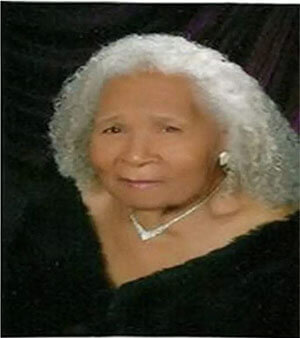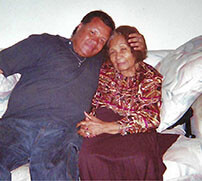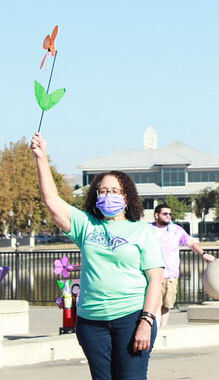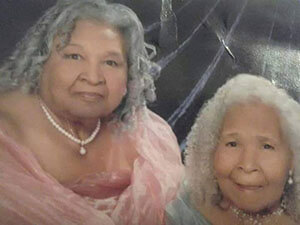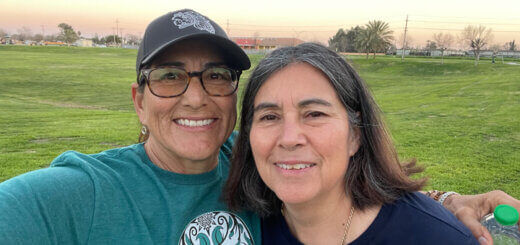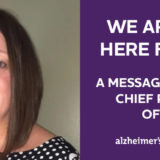Solano County resident advocates for resources in/for underserved communities
Cheryl Johnson is an Alzheimer’s Association® advocate whose mother, Lorene, had dementia. After Lorene’s diagnosis, Cheryl and her family felt discriminated against because she was an elderly Black woman. Now, Cheryl is doing her part as an advocate to encourage Congress to pass legislation that will help not only the Black community, but all people living with Alzheimer’s or another dementia.
Mom does it all
Lorene Jones was a beautician who attended Prairie View A&M University in Texas. After moving to Arizona with her husband, she became a mom and dedicated her time to caring for her four children. As her children got older, Lorene wanted to return to work as a beautician. Her husband built her a shop in the backyard where she worked for several years.
“My mother was the epitome of purity,” said Cheryl, Lorene’s daughter. “We used to laugh because Mom would get up in the morning and get dressed in her pearls like she had some place to go. After breakfast she would go to work in her shop, then she’d be back home at the end of the day cooking dinner. When I look back, it was like Leave it to Beaver. I have such fond memories of growing up. I wish I could be one-tenth of the woman she was.”
After being married for 26 years, Lorene and her husband got a divorce. She began working for Motorola and eventually became a production line manager. When her ex-husband was diagnosed with cancer, it wasn’t even a question for Lorene. With the help of one of their sons, Lorene moved back in with her ex-husband to care for him until he passed.
Hiding the signs
Unbeknownst to Cheryl and the rest of her siblings, Lorene’s memory had slowly been declining. Not knowing the 10 warning signs, Cheryl and her siblings assumed any memory issues were because her mom was busy and/or worried about their dying father.
“My mother was able to deflect,” said Cheryl. “I’d call and she was quick to give the phone to my father or one of my brothers. In hindsight, I don’t know if it was because she didn’t know who I was or if she wasn’t comfortable trying to have a conversation.”
Losing her way
In 2000, after their father passed, Cheryl and her siblings thought their mother’s memory problems were due to grief. However, after getting lost on the way home from the grocery story, they knew they needed to get help.
“She had gotten in the car to go to grocery store that was maybe a mile away,” said Cheryl. “She got lost and couldn’t figure out how to get home. This was before cell phones. We had the police looking for her and when they found her, she was confused.”
Cheryl took Lorene to see her primary care doctor who agreed there was some cognitive impairment but didn’t diagnose her beyond that.
Facing stigma
According to the Alzheimer’s Association 2020 Alzheimer’s Disease Facts and Figures report, medical school and residency programs in primary care offer very limited coursework and patient contact related to Alzheimer’s and other dementias. Despite this, fewer than half of primary care physicians (PCPs) have pursued additional training in dementia care since medical school and residency, claiming that there are challenges being able to get training.
Twenty seven percent of PCPs report not being comfortable answering patient questions about Alzheimer’s or other dementias. Moreover, even though most diagnoses are made by PCPs, 39% report not being comfortable making a diagnosis of Alzheimer’s or other dementias.
After leaving the doctor, Cheryl and her family felt a little lost. “[Not all primary care] doctors are trained on what to do,” said Cheryl. “They give you a pamphlet to read up about it and to make the best out of life. My mother didn’t have an opportunity to have any say her quality of life.”
Cheryl also felt that because her mother was an elderly Black woman on Medicare, she was discriminated against. “Old people are tossed away,” said Cheryl. “If you’re an old Black person, you can forget it. You won’t get the same services if you were a White male or female.
“You see that in the disparity in our health system across the board regardless of health problems. A Black person walks into the building, and [the staff] just assume you’re on welfare or are low income. It’s a stigma that needs to go away.”
Making a new friend
Cheryl’s brothers had a hard time accepting that their mother had some form of dementia. They continued to remind her that she’d already told that story or insist she should know where misplaced items were. “It was a battle between me and my brothers,” said Cheryl. “They were feeling so much frustration and anger at the loss of my mother. They didn’t want to let go of her.”
Cheryl, however, took this as an opportunity to make a new friend out of her mother. “What people need to know is that even though you’re giving up this person you knew as a parent, you have an opportunity to gain a friendship with a new person,” said Cheryl. “She and I would sit and talk, and I built this friendship. I loved this person, this new lady that came in my life.
“She used to tell me, ‘Oh you’re such a nice lady. I will never forget you because I have a daughter named Cheryl too,’ and she would tell me stories about Cheryl. For her not to know me was the hardest thing. To accept and love me as this person who used to visit her, it’s a tradeoff.”
Taking care of her own
Since Lorene was already living in her ex-husband’s house, the family decided she would stay there. Cheryl’s brothers moved in with their mother to care for her. They soon realized they needed more help and Lorene’s sister moved in as well.
“In the Black community, we take care of our own,” said Cheryl. “My grandmother took care of her sister until she passed away. My mother’s sister came and took care of her until she passed. That’s our community.”
Lorene passed in December 2013, just two weeks before her 88th birthday.
Signing up for Walk
In 2020 Cheryl joined the Advisory Council on Aging in Solano County. They ask their members to see what certain groups are doing in their community. Having had experience with dementia, Cheryl chose to work with the Alzheimer’s Association.
In her first meeting with the Alzheimer’s Association, she was introduced to the Walk to End Alzheimer’s® and asked to start a team. Walk to End Alzheimer’s is the world’s largest fundraiser for Alzheimer’s care, support and research.
“It was two weeks before the Walk in 2020,” said Cheryl. “I was told it was virtual that year and I should get a team. I went ahead and registered. I sent the fundraising information to my family and posted it on Facebook, Twitter and Instagram. I was everywhere. I raised enough money that I hit my goal.”
The following year, in 2021, the Solano County Walk manager approached Cheryl and asked her to join the Walk Planning Committee as the Recruitment Chair. “It was so much fun. It was awesome. We exceeded our goal. The Walk Manager called me this year and asked if I was going to be on the committee again this year. Of course I am!”
Recruiting others to join
Cheryl belongs to several local organizations that support the Black community in Solano County. At first, she wanted more members of the Black community to be a part of Walk. However, she realized there was a lack of information about the disease in her community and she wanted to change that.
“I wanted to make sure we had people of color at the Walk,” said Cheryl. “There are some people [at the Walk], but it’s not a sea of faces where you can see the presence. I started hitting up a lot of my organizations.
“As I was sharing my story with some of my church members it was amazing how the walls just started to crumble and to hear them share their stories with me. A lady raised her hand and wants to be Team Captain because her husband has Alzheimer’s. I never knew.
“He was there at church and one day he just stopped coming. She would say he’s home, he’s ill. We [the church goers] never knew what it was because of that stigma and [people] not wanting to discuss it.”
Not only did Cheryl’s church start a team, but she was also able to get the local NAACP and the National Council of Negro Women (NCNW) to form teams as well. “There are people within each organization who have been touched by Alzheimer’s,” said Cheryl.
“Once we can get passed that stigma, it’s not a mental illness, it’s a disease and needs to be treated as such. It needs a care plan so you’re able to maneuver on that journey. It’s wonderful to have all of these beautiful men and woman supporting the fight to end Alzheimer’s.”
Becoming an advocate
While working on the Walk Planning Committee, an Alzheimer’s Association advocacy ambassador position became available for Congressman Garamendi’s office. Representative Garamendi represents California’s third district, which includes Solano County. Cheryl was asked to step into this role, which she did.
Alzheimer’s Association ambassadors develop and maintain a positive relationship and regular communication with their assigned member of Congress. Ambassadors lead a team of advocacy volunteers in sharing their personal connections to dementia with the member’s office through activities like legislative meetings, joint community education events and social media.
As an ambassador Cheryl works with Congressman Garamendi and his staff to encourage them to support federal policies that will help advance Alzheimer’s care, support and research.
Currently there are three pieces of legislation Cheryl and other Alzheimer’s Association advocates would like to see passed:
- Increase research funding
- Increase research finding at the National Institutes of Health (NIH) to $289 million
- Implement the BOLD Infrastructure for Alzheimer’s Act at the Centers for Disease Control and Prevention (CDC)
- Pass the ENACT Act
- Increase the participation of underrepresented populations in Alzheimer’s and other dementia clinical trials by expanding education and outreach to these populations (Black, Hispanic, Asian or Native American), encouraging the diversity of clinical trial staff and reducing participation burden, among other priorities.
- Tell Congress: Medicare must cover FDA-Approved Treatments
- The Centers for Medicare & Medicaid Services (CMS) issued a draft decision effectively proposing to deny Medicare access to Food and Drug Administration (FDA)-approved medications for Alzheimer’s disease. Medicare has always covered FDA-approved treatments for those living with other conditions like cancer, heart disease and HIV/AIDS.
- People living with Alzheimer’s and their doctors should be able to decide if an FDA-approved treatment is right for them and should have it covered by Medicare.
- The Alzheimer’s Association is asking CMS to reverse this draft decision
More access to clinical trials
Cheryl is most passionate about the ENACT Act. Her hope is that it will allow more people of color access to clinical trials. Clinical trials are research studies conducted with human volunteers to determine whether treatments are safe and effective. Without clinical research and the help of participants, there can be no treatments, prevention or cure for Alzheimer’s disease
“Alzheimer’s disease affects the Black population more than any other community,” reminds Cheryl. “We need to ensure the medications coming out are effective for us. It’s not one size fits all. We need to ensure this medication is going to be able to help us. If we’re not in the clinical trials, we’ll never know. We will continue to suffer with the disparities in health care.”
Your voice, your vote
Cheryl encourages others to participate in advocacy so that they will have a voice in the things that affect them. “Your voice is your vote against anything,” said Cheryl. “If we don’t speak out, then we can’t complain about anything. People gave their lives so we can have freedoms and privileges and rights. We need to stand firmly, be heard and take care of our own.”
Interested in becoming an Alzheimer’s Association advocate? Sign up today at alz.org/advocate.
Want to learn more about becoming a member of the Walk to End Alzheimer’s Planning Committee? Find out more about one of our 18 Walk locations in Northern California and Northern Nevada.
Learn more:





